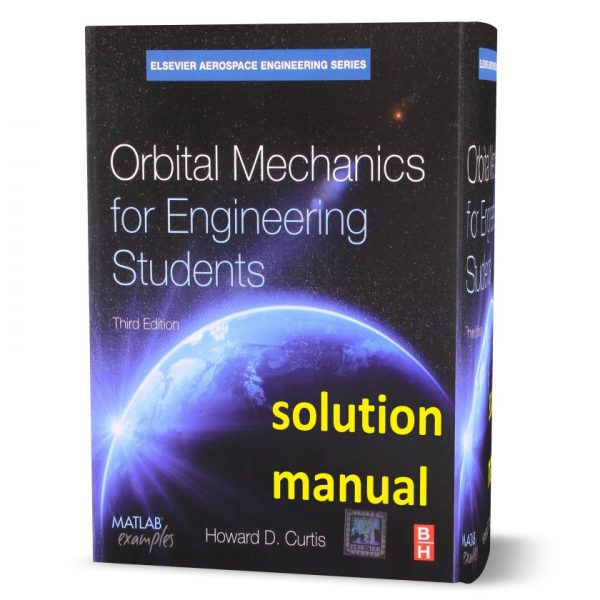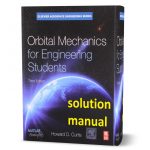Orbital Mechanics for Engineering Students 3rd edition solution manual pdf
Original price was: $20.00.$17.00Current price is: $17.00.
Published: Butterworth-Heinemann 2019
Edition: 3rd
Pages: 588
Type: pdf
Size: 8MB
Content: This solution manual include all chapter of 1 to 12 answers
Sample: solution sample file
Download After Payment
- Description
- Reviews (0)
Description
Description
The purpose of this Download free Orbital Mechanics for Engineering Students Howard Curtis 3rd edition solution manual pdf | solutions is to provide an introduction to space mechanics for undergraduate engineering students. It is not directed toward graduate students, researchers, and experienced practitioners, who may nevertheless find useful review material within the book’s contents. The intended readers are those who are studying the subject for the first time and have completed courses in physics, dynamics, and mathematics through differential equations and applied linear algebra. for more solution manual click here.
Orbital Mechanics for Engineering Students 3rd edition solution manual pdf
I have tried my best to make the text readable and understandable to that audience. In pursuit of that objective I have included a large number of example problems that are explained and solved in detail. Their purpose is not to overwhelm but to elucidate. I find that students like the “teach by example” method. I always assume that the material is being seen for the first time and, wherever possible, I provide solution details so as to leave little to the reader’s imagination. The numerous figures throughout the book are also intended to aid comprehension.
For this, the fourth edition, I have retained the content and style of the previous editions and corrected all the errors discovered by me or reported to me by readers.
The organization of the Download free Orbital Mechanics for Engineering Students Howard Curtis 3rd edition solution manual pdf | solutions remains the same as that of the third edition. Chapter 1 is a review of vector kinematics in three dimensions and of Newton’s laws of motion and gravitation. It also focuses on the issue of relative motion, crucial to the topics of rendezvous and satellite attitude dynamics. The material on ordinary differential equation solvers will be useful for students who are expected to code numerical simulations in MATLAB or other programming languages. Chapter 2 presents the vector based solution of the classical two-body problem, resulting in a host of practical formulas for the analysis of orbits and trajectories of elliptical, parabolic, and hyperbolic shape.
Orbital Mechanics for Engineering Students 3rd edition
The restricted three-body problem is covered to introduce the notion of Lagrange points and to present the numerical solution of a lunar trajectory problem. Chapter 3 derives Kepler’s equations, which relate position to time for the different kinds of orbits. The universal variable formulation is also presented. Chapter 4 is devoted to describing orbits in three dimensions. Coordinate transformations and the Euler elementary rotation sequences are defined. Procedures for transforming back and forth between the state vector and the classical orbital elements are addressed. The effect of the earth’s oblateness on the motion of an orbit’s ascending node and eccentricity vector is described, pending a more detailed explanation in Chapter 10. Chapter 5 is an introduction to preliminary orbit determination, including Gibbs’ and Gauss’ methods and the solution of Lambert’s problem.
chapter content of mechanical engineering students solution manual
The important topic of spacecraft control systems is omitted. However, the material in this book and a course in control theory provide the basis for the study of spacecraft attitude control. Understanding the material and solving problems requires using a lot of undergraduate mathematics. Mathematics, of course, is the language of engineering. this Download free Orbital Mechanics for Engineering Students Howard Curtis 3rd edition solution manual pdf | solutions Students must not forget that the English mathematician and physicist Sir Isaac Newton (1642–1727) had to invent calculus so he could solve orbital mechanics problems in more than just a heuristic way.
chapter content of mechanical engineering students fourth edition
Newton’s 1687 publication Mathematical Principles of Natural Philosophy (“the Principia”) is one of the most influential scientific works of all time. It must be noted that his contemporary, the German mathematician Gottfried Wilhelm von Leibnitz (1646–1716) is credited with inventing infinitesimal calculus independently of Newton in the 1670s.
In addition to honing their math skills, students are urged to take advantage of computers (which, incidentally, use the binary numeral system developed by Leibnitz). There are many commercially available mathematics software packages for personal computers. Wherever possible they should be used to relieve the burden of repetitive and tedious calculations.



Reviews
There are no reviews yet.